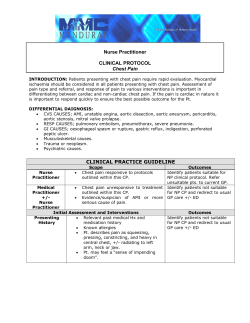
10 Common Professional Insurance Claim Issues—and How to Avoid Them
10 Common Professional Insurance Claim Issues—and How to Avoid Them By Mike Priddle, AIIC Insurance Adjustor for AON Reed Stenhouse Inc. Presented at CGA‐BC APPM 2009 No practitioner sets out to create a situation ending in an insurance claim, but if one does arise, the loss of billable time can be substantial. On average, 40‐50 hours are involved. But there are steps practitioners can take to reduce their risk of facing a claim. The underlying factor giving rise to insurance claims is lack of communication between practitioner and client. The two most common causes for claims are: • late filing of corporate and personal tax returns, and • counter claims from fee account collection actions. The following lists common claim issues and solutions to avoiding them. 1. Late filing of corporate and personal tax returns A difference in expectations between practitioner and client when filing tax returns can lead to an insurance claim. This has its source in accepting engagements under tight timelines. It is the practitioner’s obligation to caution the client that the work may not get done on time if the client does not supply information in a timely manner. If the engagement is accepted without conditions, the practitioner is bound by any time limitations that may exist. Solutions: • Have the client sign an acknowledgement that they have been advised of the potential late filing. • At a minimum, make a note of this discussion in the client’s file. • Determine the firm’s deadlines for acceptance of work from clients during tax season. Ensure that clients are cautioned that their returns may be filed late if their work arrives after the firm’s deadline. • Implementing an abeyance system can cut down on late filings by alerting staff to impending deadlines. 2. Accelerated filings may be required when bonus paid Template letters to instruct clients on when to remit withholdings on bonuses paid may not take accelerated filing timing into account. Clients may not understand that withholdings on bonuses are incorporated into regular payroll remittance requirements. If the bonus withholdings causes the entire period’s payroll withholdings to cross a threshold, an accelerated remitting period applies. Clients tend to follow remitting dates used in the template letter and if this letter does not take accelerated remitting into account, the client will be facing interest and penalties due to late filing. Solution: Customize each letter to the client’s payroll remittance requirements. 3. Providing tax advice The courts look to the practitioner to ensure that all relevant information has been obtained to allow for accurate advice given to the client. This is especially important in the area of tax. Casual conversations requesting tax advice, even if an approximate answer is being requested, can lead to an insurance claim. Solutions: • Avoid providing professional advice in a casual manner or environment. • When providing tax advice, send a letter to the client: o Confirming what was requested by the client, o Stating the facts received from the client to confirm accuracy and completeness, o Cautioning the client that the practitioner’s advice is based on the facts as presented by the client, and o Stating that any change in the facts, or omission of facts, could materially change the practitioner’s advice. 4. Use of engagement letters The engagement letter outlines the services to be provided by the practitioner. Its use does not provide 100 per cent defense against an errors or omissions lawsuit but can provide some protection. Solutions: • Review the engagement letter on a regular basis and change when circumstances warrant. • If the client does not respond to mailing them a new engagement letter with a request to sign and return, follow up with another letter. That second letter could state, “As you have not responded to my letter dated mo/day/20xx, noting changes to our engagement letter, I presume you find the changes acceptable.” This places responsibility on the client to sign. 5. Document discussions The courts consider the practitioner the professional, so without a documented file, the courts generally rule in favor of the lay person if it comes down to the client’s opinion versus the practitioner’s. Solutions: • Document important client telephone or in‐person meetings using either a written form or diary notes on your system. Date documents and clearly indicate who the conversation was with, the topic and the discussion details. • Date‐stamp all incoming documents to prove arrival at your office. • Remember that file documents are admissible to the courts; do not place anything in a file that you do not want disclosed in the future. 6. Counter claims for outstanding fees When practitioners try to settle outstanding fees in small claims court, they tend to end up with the client lodging a counter claim. The client does this to avoid paying fees. This turns the situation into a lawsuit, which is time‐consuming for the practitioner. Solutions: • Use regular interim billing practices for engagements incurring significant billable hours. • Collect these billings regularly. • When clients ignore payment of fees for an extended period, suspend services until payment is received. 7. Practicing in unfamiliar areas Practicing in unfamiliar areas increases the risk of making errors or omissions, and can easily lead to insurance claims. Solutions: • Search out and retain an expert or find other resources when dealing in areas of inexperience. • If you aren’t willing to use other resources, choose not to practice in unfamiliar areas. 8. Personal problems affecting the practice Personal problems experienced by the practitioner can result in lack of attention to client files. Solutions: • Make use of AON’s Practitioner and Family Assistance Program. One of its main services is counseling. • Reduce your workload by delegating. • Monitor staff’s workloads, look out for signs of overwhelmed individuals. • Have a contingency plan in case a long‐term illness develops. This needs to include a network of fellow practitioners. 9. Client selection When building your practice, determine what qualities you require when accepting new clients. Problem clients can cost you in the long‐term. Solutions: • Trust your initial sense of the client’s quality. • Give serious consideration to not accepting clients who frequently change accounting firms or have outstanding billings. • Consider divesting yourself of clients who do not provide information on a timely basis or do not regularly pay their fees. 10. Don’t delay reporting a claim Do not ignore incidents causing you concern regarding potential claims, whether they are groundless or not. Late reporting or non‐reporting can lead to needless lawsuits. Solution: • Report the situation as soon as you become aware of it to increase the probability of early correction to potentially avoid a lawsuit. The number of incidents reported does not increase practitioners’ insurance rates or their ability to obtain insurance coverage. And all claims information is kept strictly confidential. Contact Information: To contact Mike Priddle, email mike@nwadj.ca or phone (780) 483‐3481.
© Copyright 2025





















